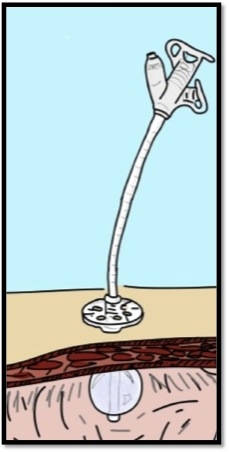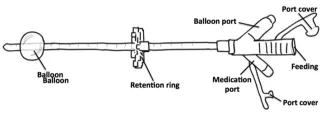Instructions for Use and Care of the MIC-KEY™ Skin Level Gastrostomy Tube | Overview

A MIC-KEY™ skin-level gastrostomy tube (g-tube) has been put into your child’s stomach through a hole called a “stoma.” This g-tube has both a water-filled balloon inside the stomach and a disk sitting on the outside of the stomach to help hold it in place.
(At left: Figure 1: Illustration of MIC-KEY™ tube in stomach.)

What supplies do I need?
- a MIC-KEY™ right angle extension set for continuous feeding OR straight extension set for bolus feeding
- 30 to 60 cc catheter tip syringe
- 5 to 10 cc slip tip syringe
- soap and water for cleaning equipment
- distilled or sterile water for balloon
How do I care for the MIC-KEY™ g-tube?
- Wash the skin around and under the g-tube each day with mild soap and water. If you use a dressing, change it every day or when it becomes wet so the skin does not become irritated.
- Check the skin around and under the g-tube each day for signs of irritation. If the MIC-KEY™ g-tube is too snug and causing irritation to the skin, call your doctor to talk about if a longer g-tube is needed.
Follow these steps to check the amount of water in the balloon once a week
The MIC-KEY™ g-tube balloon holds the tube in place. You should check the amount of water in the balloon once a week, on the same day each week.
- Attach a 5 or 10 cc slip tip syringe to the MIC-KEY™ g-tube balloon port.
- Hold the g-tube in place, and gently pull back on the syringe to withdraw the water from the balloon.
- Check to make sure your child’s balloon has the prescribed amount of water. If the amount is correct, push the water back into the balloon. Then keep your finger on the end of the syringe and gently disconnect from balloon port. Keeping pressure on the syringe is important to prevent water from flowing back into the syringe. If there is less water than there should be in the balloon, add water using the syringe to make up the right amount. For example, if you were told there was 5 cc/ml of water and now there is 4 cc/ml, add an additional 1 cc/ml of water to the balloon, using the syringe.
- Only use distilled water or sterile water. Never fill the balloon with air. Air will leak out and the MIC-KEY™ g-tube will not stay in place.
- If the MIC-KEY™ g-tube balloon has less water than prescribed every week, there may be a slow leak. If you think there is a slow leak, please do one of these things:
- Change the g-tube if you have been trained. You may refer to home care instructions for changing the MIC-KEY™ skin level gastrostomy tube.
- If you have not yet been trained how to change the MIC-KEY™ g-tube, call your GI doctor or nurse to schedule a tube change.
How do I give feedings using the MIC-KEY™ g-tube?
Refer to these information sheets for instructions on how to give feedings:
How do I give medicine using the MIC-KEY™ g-tube?
- Give liquid medicine when possible through the g-tube. ALWAYS flush with at least 3 to 10 cc/ml of water (unless you have been told a different amount) before and after giving medicine to avoid clogging the g-tube.
- After giving thick medicine, flush with extra water to help stop the g-tube from clogging. If your child is on a fluid restriction, talk to your doctor or nurse about how much water to use.
- If a medicine is only available in tablet or capsule form, check with your pharmacist and doctor to be sure it can be safely crushed. Pills should be crushed into a fine powder and completely dissolved in water before giving through the g-tube. You can buy a pill crusher at a local pharmacy.
- Do not mix one medicine with another or put medicine in formula, unless clearly told to do so by your child’s GI doctor. Some medicines do not mix well together.
- Use the bolus (straight) extension set when giving crushed pills or contents of opened capsules, mixed with fluid, through the g-tube. Always flush the g-tube with water after the medicine has been given to stop the g-tube from clogging.
- You may give medicine through the medicine port on the right angle extension set while your child is receiving a continuous feeding. You will need to pause the feeding before giving the medicine.
What should I do if the MIC-KEY™ g-tube falls out?
- Change the g-tube if you have been trained. Refer to the home care instructions for changing the MIC-KEY™ skin level gastrostomy tube for step-by-step instructions on how to change the g-tube.
- If you do not know how to change the g-tube or do not have a new g-tube at home, place the old g-tube back in the stoma and cover the site with a gauze dressing. Then call your doctor’s office to have the g-tube replaced.
Important tips
- Always keep an extra MIC-KEY™ g-tube on hand. Your child’s doctor or nurse will either directly give you or send off a prescription for this new g-tube to your home care supply company. Please call your home care supply company to make sure your child has active prescriptions with refills for replacement MIC-KEY™ g-tubes.
- Remove the extension tube after giving feedings or medicine. Wash the tubing with warm water and mild soap, and rinse well. Let air dry and then store in a clean area until the next use. Leaving the extension tube in place for too long may damage the one-way valve in the MIC-KEY™ and cause leaking.
- You should replace the MIC-KEY™ g-tube every three to six months or sooner if:
- Fluid is leaking from the middle of the g-tube. (This may mean the g-tube’s one-way valve is broken.)
- If 2 to 3 cc/ml of water is missing from the balloon after two weekly balloon checks.
- If the MIC-KEY™ g-tube is sticking out from the stomach more than when it was first placed, gently push it down flat against the surface of your child’s belly and check the amount of water in the balloon (see instructions above).
When should I call my child’s doctor or nurse?
Call if:
- you have any questions or concerns about your child’s g-tube
- if the tube is clogged
- the skin around the g-tube is red, swollen, warm, sore, or bleeding
- the stoma has a strange smell
- there is pus or drainage around the g-tube
- your child has a fever of 101 degrees F along with any of the above problems
- your child throws up more than three times in 24 hours
- the g-tube falls out and you cannot easily replace it
- there is any redness or soreness around the skin that does not get better with routine skin care and dressing changes
Who can I call if I have questions?
Please call the GI office at 617-355-6058 if you have questions or concerns. Our GI nurses can help you with all types of questions:
- 8 a.m. to 4:30 p.m. weekdays: A nurse in the GI clinic will be available to help you.
- Weekdays after 4:30 p.m., weekends, holidays: Use the same number to reach a GI doctor on-call for urgent questions or emergencies.
If your child is followed by General Surgery:
- 8:30 a.m. to 5 p.m. weekdays: Call the General Surgery outpatient nurses at 617-355-7716 or 617-355-7704.
- Weekdays after 5 p.m., weekdays, holidays: Call the Boston Children’s page operator at 617-355-6369 and ask for the general surgery senior resident on-call.
